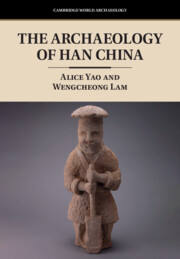Book contents
- The Archaeology of Han China
- Cambridge World Archaeology
- The Archaeology of Han China
- Copyright page
- Contents
- Plates
- Figures
- Tables
- Acknowledgements
- Introduction
- Part I Imperial Geography
- Part II Food Production and Foodways
- Part III Crafts
- Part IV Death Ritual
- 7 The (Un)Dead and the Role of Ritual in the Crafting of Sociopolitical Networks
- 8 Mourning Practices and the Cultivation of Selves – Views from the Hexi, Ordos, and Lingnan
- Conclusion
- Glossary of Chinese Names and Places
- References
- Index
- Plate Section (PDF Only)
8 - Mourning Practices and the Cultivation of Selves – Views from the Hexi, Ordos, and Lingnan
from Part IV - Death Ritual
Published online by Cambridge University Press: 12 December 2024
- The Archaeology of Han China
- Cambridge World Archaeology
- The Archaeology of Han China
- Copyright page
- Contents
- Plates
- Figures
- Tables
- Acknowledgements
- Introduction
- Part I Imperial Geography
- Part II Food Production and Foodways
- Part III Crafts
- Part IV Death Ritual
- 7 The (Un)Dead and the Role of Ritual in the Crafting of Sociopolitical Networks
- 8 Mourning Practices and the Cultivation of Selves – Views from the Hexi, Ordos, and Lingnan
- Conclusion
- Glossary of Chinese Names and Places
- References
- Index
- Plate Section (PDF Only)
Summary
Chapter 8 expands on funerary practices of Yue/Viet, Qiang, and “Xiongnu” subjects and asks how and why ritual conversion, which underlines the assimilationist campaign of jiaohua, was carried out. Through a comparison of tombs belonging to indigenous and Central Plains diasporic groups, this chapter argues that cultural boundaries dividing the Han/non-Han or Huaxia/ non-Huaxia world were magnified by differences in the presentation of the deceased’s physical body along ethnic and gender norms.
- Type
- Chapter
- Information
- The Archaeology of Han China , pp. 252 - 281Publisher: Cambridge University PressPrint publication year: 2024

